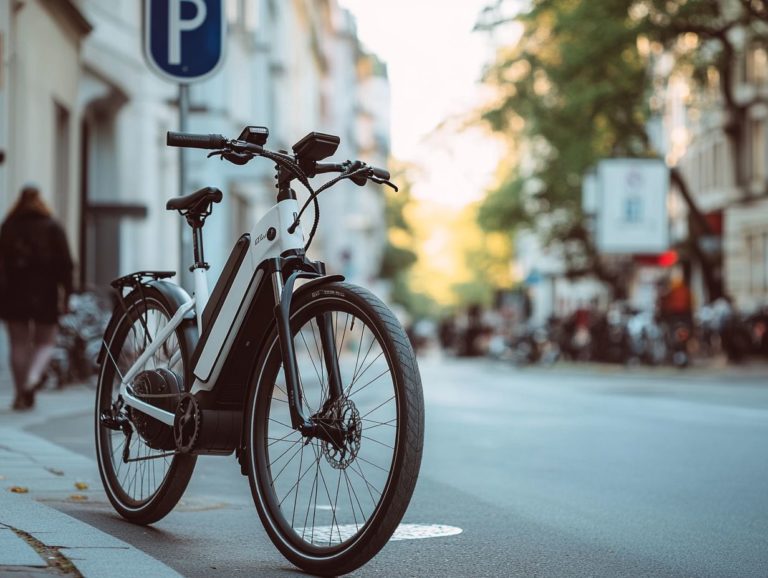What are the Laws for Electric Bicycles?
Electric bicycles are swiftly becoming a favored choice for those seeking a sustainable and efficient means of transportation. With a variety of models tailored to different needs, grasping their legal classification is essential for riders.
Let s explore the federal and state regulations governing electric bicycles, enlightening you on their environmental and personal benefits while emphasizing important safety considerations.
It outlines the rules and restrictions regarding where and how to ride, as well as the potential consequences for not adhering to these laws.
Embark on a journey to navigate the thrilling realm of electric mobility safely and responsibly.
Contents
- Key Takeaways:
- Overview of Electric Bikes
- Legal Classification of Electric Bikes
- Benefits of Electric Bicycles
- Laws for Riding Electric Bicycles
- Safety Considerations for Electric Bicycles
- Enforcement and Penalties for Violating Electric Bicycle Laws
- Frequently Asked Questions
- What are the laws for electric bicycles in the United States?
- Do I need a license to ride an electric bicycle?
- What is the maximum speed allowed for electric bicycles?
- Are there age restrictions for riding electric bicycles?
- Where can I ride an electric bicycle?
- Do I need to register my electric bicycle?
Key Takeaways:

- Electric bicycles are classified as low-speed electric bicycles and motorized bicycles, and are subject to both federal and state regulations.
- Riding an electric bicycle can have environmental benefits and personal advantages such as cost savings and improved physical health.
- When riding an electric bicycle, it’s important to follow the rules and restrictions on where and how to ride, as well as practice safety measures to avoid accidents and injuries.
Overview of Electric Bikes
Electric bikes, or e-bikes, have surged in popularity, revolutionizing your approach to commuting, exploring scenic landscapes, and enjoying leisurely activities. These remarkable vehicles seamlessly blend traditional pedaling with help from a motor when you pedal, enabling riders of all ages to embark on eco-friendly journeys.
As the e-bike market flourishes, it’s essential for you to familiarize yourself with laws about e-bikes and local regulations. This knowledge ensures that you can ride safely and responsibly while respecting the diverse definitions and classifications of e-bikes.
Definition and Types
Electric bikes can be elegantly categorized into three distinct classes: Class 1, Class 2, and Class 3. Each category is defined by its motor power and speed limits, along with specific regulations that govern e-bike use.
Class 1 electric bicycles offer a harmonious riding experience, featuring a motor that assists only when you re pedaling. This means you can enjoy the ride while the bike supports you up to a top speed of 20 mph.
In contrast, Class 2 bikes come equipped with a throttle, allowing you to engage the motor without pedaling, also capped at 20 mph. This makes them particularly well-suited for those who might appreciate a little extra assistance on their journeys.
On the other hand, Class 3 electric bicycles are designed for speed, capable of reaching up to 28 mph with pedal assist, thereby delivering a more dynamic riding experience.
When considering various types of e-bikes, such as electric mountain bikes, it s crucial to understand how they fit within these classifications. Many are specifically tailored for the challenges of trail riding while adhering to the regulations imposed by their respective classes.
Legal Classification of Electric Bikes
The legal classification of electric bicycles varies significantly across the United States, shaped by federal laws and different state regulations.
It s crucial for you to grasp your rights and responsibilities under these laws as a cyclist, ensuring you navigate the landscape with confidence and awareness.
Federal and State Regulations
Federal and state regulations concerning electric bicycles create a complex framework for e-bike usage, with laws and guidelines that vary widely across states like California, New Jersey, and Florida.
These laws evolve with societal trends towards sustainable transport while also addressing critical safety and road usage issues. For example, Alabama may offer more lenient regulations for e-bike riders, while New York imposes stricter requirements, such as mandatory registration and potential licensing based on the specifications of the e-bike. To learn more about these differences, check out the electric bicycle regulations: a global overview.
Local ordinances add another layer of complexity, influencing where you can legally ride your e-bike. This patchwork of regulations can significantly shape your riding experience, making it essential for you to stay informed about the specific requirements and limitations applicable in your area.
Are you ready to join the electric bike revolution? Stay informed and ride safely!
Benefits of Electric Bicycles

Electric bicycles present an array of advantages that elevate your personal mobility while simultaneously supporting environmental sustainability. This combination makes them an exceptional choice for outdoor adventures and eco-conscious journeys.
Environmental and Personal Advantages
The environmental benefits of electric bicycles are truly remarkable, offering everything from reduced greenhouse gas emissions to promoting green travel that inspires outdoor exploration.
But it doesn’t stop there; you also gain significant personal advantages as a rider. Electric bikes provide a cleaner, more exciting way to travel, easing traffic congestion and enhancing air quality. By riding an electric bike, you not only contribute to a smaller carbon footprint, but you also boost your fitness levels, as regular biking can greatly enhance cardiovascular health.
The convenience of electric bikes, which often facilitate quicker commutes and the ability to navigate challenging terrains, makes them an appealing choice for anyone. Just remember to keep local biking regulations in mind, as they can dictate where you can ride, speed limits, and bike lane usage. For more information on this topic, consider navigating electric bicycle licensing requirements, which ultimately shapes your overall experience and benefits.
Laws for Riding Electric Bicycles
Understanding the laws governing electric bicycles is essential for ensuring your compliance with e-bike regulations, which can vary significantly from one region to another. These laws dictate not only where you can ride but also how you can use your e-bike, including access to bike paths and public roads.
Familiarize yourself with these guidelines. They help you ride confidently and responsibly.
Rules and Restrictions on Where and How to Ride
Rules regarding where and how you can ride electric bicycles are dictated by local jurisdictions and e-bike laws, which lay out specific regulations for bike paths and public road use.
These rules vary by region, affecting both the types of e-bikes permitted and the environments in which you can ride them. For comprehensive information, check out Understanding Electric Bicycle Safety Regulations. In many areas, you’re allowed to operate an e-bike on designated bike paths, as long as you stick to the established speed limits, typically capped at 15 to 20 miles per hour.
Local guidelines may also specify the conditions under which you can use an e-bike on public lands, including forests and parks, where certain restrictions might be in place to ensure the safety and enjoyment of all trail users. It’s essential to familiarize yourself with state-specific classifications of e-bikes, as these can greatly influence your riding experience and help you stay compliant with the relevant laws, including electric bicycle age restrictions by state.
Safety Considerations for Electric Bicycles
Safety considerations for electric bicycles are essential, including rules about helmet requirements, e-biking safety practices, and adherence to riding limits. By following these principles, you can ensure that your riding experience is not only enjoyable but also responsible.
Tips for Safe Riding

To ensure a safe riding experience, embrace best practices that prioritize e-biking safety, paying careful attention to established safety considerations, including a clear understanding of your riding limits.
This means regularly checking your bike s condition making sure the tires are properly inflated and the brakes are functioning effectively. Always wear a helmet! It could save your life. Don’t underestimate the power of wearing appropriate safety gear; a certified helmet, padded gloves, and reflective clothing can significantly enhance your protection during rides.
Being aware of local traffic rules is essential, as it enables you to navigate urban environments responsibly while minimizing risks. Keeping a safe distance from vehicles and staying alert to blind spots further contributes to a secure journey, allowing you to enjoy your rides without unnecessary worry.
Ready to ride? Check your local laws and get started today!
Enforcement and Penalties for Violating Electric Bicycle Laws
Enforcing electric bicycle laws is essential for ensuring safety on the roads. Various penalties have been established for violating e-bike regulations set by local jurisdictions, particularly concerning riding limits and the improper use of bike paths.
Adhering to these laws protects you and contributes to a safer environment for everyone.
Consequences for Breaking Regulations
The consequences for breaking electric bicycle regulations can vary significantly. These often hinge on the specific e-bike laws enforced by your local jurisdiction.
You might face fines, have your bike confiscated, or deal with other legal ramifications.
For instance, in certain U.S. cities, ignoring local speed limits could result in fines ranging from $50 to $200. If you improperly use bike lanes, a ticket might be awaiting you.
In California, riding without the proper safety gear can lead to penalties. These may include monetary fines and mandatory safety courses definitely not a fun way to spend your time.
In London, regulations are strict. Police may confiscate your electric bike if it exceeds motor strength limits, illustrating how enforcement tactics can differ across regions. Some jurisdictions impose points on your driving record.
Every electric bike enthusiast must stay informed about local laws to avoid surprises!
Frequently Asked Questions
What are the laws for electric bicycles in the United States?
In the US, electric bicycles are regulated by the federal government and individual state laws. These laws dictate the maximum speed, power, and where they can be ridden. It is important to check with your state’s department of transportation for specific regulations.
Do I need a license to ride an electric bicycle?

In most states, a license is not required to operate an electric bicycle. However, some states may require a driver’s license, motorcycle license, or permit for certain classes of electric bicycles. Always check with your state’s department of transportation for specific regulations.
What is the maximum speed allowed for electric bicycles?
In the US, the maximum speed allowed for electric bicycles is typically 20 mph, although some states may have different regulations. It’s essential to verify with your state’s department of transportation for specifics.
Are there age restrictions for riding electric bicycles?
In most states, there are no age restrictions for riding electric bicycles. However, some states may have minimum age requirements for certain classes of electric bicycles. Always refer to your state’s department of transportation for specific regulations.
Where can I ride an electric bicycle?
The laws for riding electric bicycles vary by state, but in general, they can be ridden on most roads and bike paths where traditional bicycles are allowed. However, some states may restrict riding electric bicycles on sidewalks or certain types of trails. Always check with your state’s department of transportation for specific regulations.
Do I need to register my electric bicycle?
In most states, electric bicycles do not need to be registered. However, some states may require registration for certain classes of electric bicycles. It’s best to confirm with your state’s department of transportation for specific regulations.






